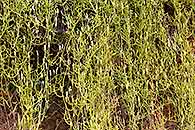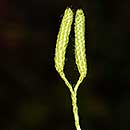Lycopodium clavatum L.
Synonyms |
Lycopodium clavatum L. var. inflexum (P. Beauv.) Spring |
|---|---|
Common name |
|
Description |
Main stem branched, creeping, giving rise to erect, unequally dichotomously branched, secondary stems 20-60(-80) cm tall at intervals of 5-10 cm. Foliage leaves set at right angles to branches, with tip bent forwards, suberect or overlapping, uniform, linear-lanceolate in outline, 3-7 × 0.3-0.75 mm, margins entire, apex with a fine hair-like point up to 3 mm, margin usually entire but some stem leaves might be ciliate; the apical hairs appear tufted at the end of the young shoots and dry a characteristic orange-brown colour. Fertile parts arranged in strobili; strobili 2-6, 1-8 x 0.4-0.6 cm, cylindrical, borne on a slender, sparsely leaved, simple or branched peduncle up to 22 cm long. Sporophylls broadly ovate in outline, up to 3 × 2 mm, acuminate into a long hair-point, margins finely lacerate. |
Notes | Easy to recognize by its branched erect stems arising from a creeping stem. |
Derivation | clavatum: club-shaped, referring to the shape of the stalked strobilus. |
Habitat | Forest margins, streambanks in montane areas and in full sun along road embankments. |
Distribution worldwide | Africa, Madagascar, Mascarene Islands and in temperate climates throughout most of the world. |
Distribution in Africa |
Angola, Burundi, Cameroon, Dem. Republic of Congo, Equatorial Guinea (incl. Bioko), Ethiopia, Guinea, Ivory Coast, Kenya, Lesotho, Malawi, Mozambique, Nigeria, Rwanda, Sierra Leone, South Africa, Sudan and South Sudan, Swaziland, Tanzania , Uganda, Zambia, Zimbabwe. |
Growth form |
Terrestrial. |
Literature |
|




